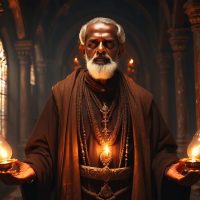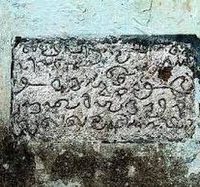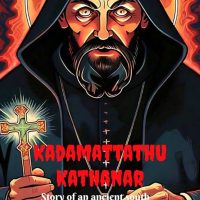Kadamattathu Kathanar : The Sorcerer Priest of Kerala
Listen
At a glance
| Description | |
|---|---|
| Origin | Indian Mythology |
| Classification | Mortals |
| Family Members | N/A |
| Region | India |
| Associated With | Magic, Occult |
Kadamattathu Kathanar
Introduction
Kadamattathu Kathanar is among the most fascinating figures in Kerala’s folklore, remembered as a priest who wielded extraordinary magical powers. Rooted in the 9th century and tied to the Syrian Christian traditions of Kerala, his story blends the sacred with the supernatural, creating a unique cultural legacy. While historical evidence about his life is scarce, oral traditions and texts such as Aithihyamala have preserved tales of his sorcery, his battles with spirits, and his role as a protector of ordinary people. The Kadamattom Church, where he served, is deeply associated with his legend, making him both a religious and mythological icon in Kerala’s collective memory.
Physical Traits
Unlike many mythological figures, Kadamattathu Kathanar is not remembered for extraordinary physical beauty or strength, but for the commanding presence he carried. Folklore describes him as tall, with a solemn and dignified aura that commanded respect. His priestly robes symbolized his ecclesiastical role, while his piercing gaze and calm demeanor reflected his mystical authority. In local storytelling traditions, he is often imagined as a figure who could inspire both reverence and unease, embodying the dual nature of a man of God and a master of sorcery. His charisma and spiritual intensity were believed to grow stronger when he confronted spirits or performed magical feats.
Family
Kadamattathu Kathanar was born as Poulose in the village of Kadamattom, located in present-day Ernakulam district, Kerala. His childhood was marked by tragedy, as he lost both parents at a very young age and was left orphaned. Despite this difficult beginning, his life took a transformative turn when he was adopted by the Persian priest Mar Abo (also known as Mar Sabor Iso), who had established a strong presence among the Saint Thomas Christians of Kerala. Under Mar Abo’s mentorship, Poulose received religious education, was introduced to Syriac Christian traditions, and later ordained as a deacon at the Kadamattom Church. This mentorship not only gave him a place in ecclesiastical history but also shaped his spiritual journey, which would later intertwine with legends of sorcery.
Other names
Over the centuries, Kadamattathu Kathanar has been known by various names that reflect different stages of his life and the evolving nature of his legend. His given name was Poulose, though during his youth he was fondly called Kochu Poulose. As he grew into priesthood, he became known as Father Poulose, or in Malayalam, Kadamattathachan, meaning “Father of Kadamattom.” In older manuscripts and folklore records, he is sometimes referred to as Cattanar, an archaic form of his priestly title. More recently, storytellers and popular culture have embraced the title “Sorcerer Priest,” which encapsulates his enduring reputation as a figure who bridged Christian spirituality with magical traditions.
Powers and Abilities
The heart of Kadamattathu Kathanar’s legend lies in his powers, which elevated him from an ordinary priest to a figure of myth. Stories suggest that his magical knowledge was acquired during a long captivity with the Mala Arayas, a tribal community reputed to practice ancient forms of sorcery and ritual magic. According to folklore, he was initiated into their mystical practices before eventually returning to Kadamattom, where he used these powers for the greater good.
His abilities, as described in oral traditions, were vast. He was said to exorcise malevolent spirits and cure people suffering from possessions. He could command the elements, calm storms, and summon rain during times of drought. Tales also recount how he could communicate with animals and even tame ferocious beasts, including tigers. Some stories credit him with feats of instant creation, such as growing grapevines from a single seed within moments to provide fruit for a bishop.
Perhaps the most famous tale links him to the Yakshi Kalliyankattuneeli, a fearsome spirit who terrorized travelers. Using his wit and magic, Kathanar subdued her, transforming a dangerous supernatural entity into a servant under his control. These stories highlight his role not as a selfish magician but as a benevolent sorcerer who used his gifts to protect and aid his community.
Modern Day Influence
Kadamattathu Kathanar remains deeply embedded in Kerala’s cultural imagination, his legacy thriving across literature, art, theater, and film. His stories are among the most popular entries in Aithihyamala, the compendium of Kerala’s legends compiled by Kottarathil Sankunni in the early 20th century. They continue to be retold around hearths, schools, and in cultural performances, ensuring that his memory endures in oral tradition.
The Kadamattom Church itself remains a living monument to his story. Pilgrims and visitors often associate its Persian Cross and ancient walls with the priest’s magical battles and divine service, making it not just a religious center but a heritage site steeped in folklore.
On stage, plays such as Kadamattathu Kathanar by Kalanilayam theater troupe have kept his stories alive for generations, blending myth with performance art. Television adaptations, like the popular serial Kadamattathu Kathanar (2004–2005), brought his supernatural adventures to households across Kerala, framing him in a horror-fantasy light.
Cinema too has reimagined him repeatedly. Earlier films such as Kadamattathachan in the 1960s and 1980s brought his tales to life, while newer projects like Kathanar – The Wild Sorcerer, starring Jayasurya and slated for release in 2025, aim to reinterpret his character for modern audiences, positioning him almost like a mythic superhero. These adaptations reflect not just nostalgia for folklore but also the enduring relevance of his story in exploring the themes of faith, fear, and the supernatural.
Beyond entertainment, Kadamattathu Kathanar’s legend also inspires visual art, from painted depictions to modern digital illustrations. His figure, standing between the cross and the arcane, resonates with Kerala’s unique blend of Christian spirituality and indigenous folklore.
Related Images
Source
Wikipedia contributors. (2025). Kadamattathu Kathanar. Wikipedia. Retrieved September 20, 2025, from https://en.wikipedia.org/wiki/Kadamattathu_Kathanar
Mr Morbid. (2023, May 6). Kadamattathu Kathanar, the True Story Behind the Sorcerer Priest of Kerala. Morbid Kuriosity. Retrieved from https://morbidkuriosity.com/kadamattathu-kathanar-the-true-story/
Jose, S. T. (2020, December 10). The legendary life of Kadamattathu Kathanar. Onmanorama. Retrieved from https://www.onmanorama.com/travel/kerala/2018/06/30/ernakulam-elamkalam-kadamattathu-kathanar-priest.html
Visvanathan, S. (2016). The Legends of St. Thomas and the Extensions of the Magic/Miracle Dichotomy in the Stories About Kadamattath Kattanar 1. Taylor & Francis.
Visvanathan, S. (2022). Narratives of Hegemony and Marginalization: Deconstructing the History Legends of India. CEEOL.
Contributors to Wikimedia projects. (n.d.). Kadamattathu Kathanar – Wikipedia. https://en.wikipedia.org/wiki/Kadamattathu_Kathanar
Myths n’ Health. (2014). Kadamattath Kathanar, The Holy Priest of Kadamattom Church. http://keralamythology.blogspot.com/2014/12/kadamattath-kathanar-holy-priest-of.html
Frequently Asked Questions
What is lorem Ipsum?
I am text block. Click edit button to change this text. Lorem ipsum dolor sit amet, consectetur adipiscing elit. Ut elit tellus, luctus nec ullamcorper mattis, pulvinar dapibus leo.
What is lorem Ipsum?
I am text block. Click edit button to change this text. Lorem ipsum dolor sit amet, consectetur adipiscing elit. Ut elit tellus, luctus nec ullamcorper mattis, pulvinar dapibus leo.
What is lorem Ipsum?
I am text block. Click edit button to change this text. Lorem ipsum dolor sit amet, consectetur adipiscing elit. Ut elit tellus, luctus nec ullamcorper mattis, pulvinar dapibus leo.
What is lorem Ipsum?
I am text block. Click edit button to change this text. Lorem ipsum dolor sit amet, consectetur adipiscing elit. Ut elit tellus, luctus nec ullamcorper mattis, pulvinar dapibus leo.
What is lorem Ipsum?
I am text block. Click edit button to change this text. Lorem ipsum dolor sit amet, consectetur adipiscing elit. Ut elit tellus, luctus nec ullamcorper mattis, pulvinar dapibus leo.













